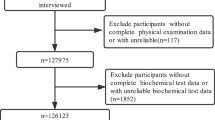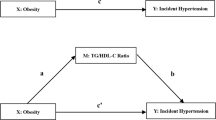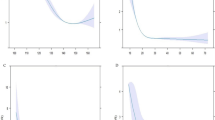Abstract
The associations between high-density lipoprotein cholesterol (HDL-C) and blood pressure (BP) or hypertension are inconsistent in previous studies. This study aimed to assess these associations in a large cohort of Chinese adults and across different age groups. This cross-sectional association study included 22,081 Chinese adults. Associations of HDL-C with BP and hypertension were analyzed using linear or logistic regression, with or without adjustment for confounding factors. HDL-C was inversely associated with BP and hypertension. These associations were still apparent after adjustment for age, sex, fasting plasma glucose, and low-density lipoprotein cholesterol. Sub-analyses revealed: (1) in the whole cohort and females alone, HDL-C was inversely associated with BP and hypertension in young and middle-aged but not older participants; (2) in males alone, HDL-C was not associated with systolic BP or hypertension. However, HDL-C was either inversely, or not, or positively associated with BP in young, middle-aged, and older males, respectively. After further adjustment for body mass index (BMI), the negative associations of HDL-C with BP and hypertension in the whole cohort became positive ones, and the positive associations only presented in males. These findings suggest that further adjustment for BMI changes inverse associations of HDL-cholesterol with BP and hypertension to positive associations in a cohort of Chinese adults.


Similar content being viewed by others
Data availability
Datasets are available from corresponding authors on reasonable request.
References
Wilson PW, D’Agostino RB, Levy D, Belanger AM, Silbershatz H, Kannel WB. Prediction of coronary heart disease using risk factor categories. Circulation. 1998;97:1837–47.
Chobanian AV, Bakris GL, Black HR, Cushman WC, Green LA, Izzo JL Jr., et al. Seventh report of the Joint National Committee on Prevention, Detection, Evaluation, and Treatment of High Blood Pressure. Hypertension. 2003;42:1206–52.
de Simone G, Devereux RB, Chinali M, Roman MJ, Best LG, Welty TK, et al. Risk factors for arterial hypertension in adults with initial optimal blood pressure: the Strong Heart Study. Hypertension. 2006;47:162–7.
Kuwabara M, Chintaluru Y, Kanbay M, Niwa K, Hisatome I, Andres-Hernando A, et al. Fasting blood glucose is predictive of hypertension in a general Japanese population. J Hypertens. 2019;37:167–74.
Bønaa KH, Thelle DS. Association between blood pressure and serum lipids in a population. The Tromsø Study. Circulation. 1991;83:1305–14.
Oda E, Kawai R. High-density lipoprotein cholesterol is positively associated with hypertension in apparently healthy Japanese men and women. Br J Biomed Sci. 2011;68:29–33.
Shimizu Y, Sato S, Koyamatsu J, Yamanashi H, Nagayoshi M, Kadota K, et al. Association between high-density lipoprotein-cholesterol and hypertension in relation to circulating CD34-positive cell levels. J Physiological Anthropol. 2017;36:26.
Hughes K, Leong WP, Sothy SP, Lun KC, Yeo PP. Relationships between cigarette smoking, blood pressure and serum lipids in the Singapore general population. Int J Epidemiol. 1993;22:637–43.
Li L, Wang Y, Cao W, Xu F, Cao J. Longitudinal studies of blood pressure in children. Asia-Pac J Public Health. 1995;8:130–3.
Cho KH, Park HJ, Kim JR. Decrease in Serum HDL-C Level Is Associated with Elevation of Blood Pressure: Correlation Analysis from the Korean National Health and Nutrition Examination Survey 2017. Int J Environ Res Public Health. 2020;17:1101.
Wakabayashi I. Associations of blood lipid-related indices with blood pressure and pulse pressure in middle-aged men. Metab Syndr Relat Disord. 2015;13:22–8.
Zhang L, Li JL, Zhang LL, Guo LL, Li H, Li D. Association and Interaction Analysis of Body Mass Index and Triglycerides Level with Blood Pressure in Elderly Individuals in China. Biomed Res Int. 2018;2018:8934534.
Yan Z, Bi-Rong D, Hui W, Chang-Quan H. Serum lipid/lipoprotein and arterial blood pressure among Chinese nonagenarians/centenarians. Blood Press. 2011;20:296–302.
Hunt SC, Stephenson SH, Hopkins PN, Williams RR. Predictors of an increased risk of future hypertension in Utah. A screening analysis. Hypertension. 1991;17:969–76.
Haffner SM, Ferrannini E, Hazuda HP, Stern MP. Clustering of cardiovascular risk factors in confirmed prehypertensive individuals. Hypertension. 1992;20:38–45.
Sesso HD, Buring JE, Chown MJ, Ridker PM, Gaziano JM. A prospective study of plasma lipid levels and hypertension in women. Arch Intern Med. 2005;165:2420–7.
Halperin RO, Sesso HD, Ma J, Buring JE, Stampfer MJ, Gaziano JM. Dyslipidemia and the risk of incident hypertension in men. Hypertension. 2006;47:45–50.
Laaksonen DE, Niskanen L, Nyyssönen K, Lakka TA, Laukkanen JA, Salonen JT. Dyslipidaemia as a predictor of hypertension in middle-aged men. Eur Heart J. 2008;29:2561–8.
Kunutsor SK, Kieneker LM, Bakker SJL, James RW, Dullaart RPF. The inverse association of HDL-cholesterol with future risk of hypertension is not modified by its antioxidant constituent, paraoxonase-1: the PREVEND prospective cohort study. Atherosclerosis. 2017;263:219–26.
Tohidi M, Hatami M, Hadaegh F, Azizi F. Triglycerides and triglycerides to high-density lipoprotein cholesterol ratio are strong predictors of incident hypertension in Middle Eastern women. J Hum Hypertens. 2012;26:525–32.
Bender AD. The effect of increasing age on the distribution of peripheral blood flow in man. J Am Geriatrics Soc. 1965;13:192–8.
Beere PA, Russell SD, Morey MC, Kitzman DW, Higginbotham MB. Aerobic exercise training can reverse age-related peripheral circulatory changes in healthy older men. Circulation. 1999;100:1085–94.
Qian T, Sun H, Xu Q, Hou X, Hu W, Zhang G et al. Hyperuricemia is independently associated with hypertension in men under 60 years in a general Chinese population. J Hum Hypertens. 2020; https://doi.org/10.1038/s41371-020-00455-7.
Cheng W, Wen S, Wang Y, Qian Z, Tan Y, Li H, et al. The association between serum uric acid and blood pressure in different age groups in a healthy Chinese cohort. Medicine. 2017;96:e8953.
Roe MT, Ou FS, Alexander KP, Newby LK, Foody JM, Gibler WB, et al. Patterns and prognostic implications of low high-density lipoprotein levels in patients with non-ST-segment elevation acute coronary syndromes. Eur Heart J. 2008;29:2480–8.
Sugiura T, Dohi Y, Yamashita S, Yamamoto K, Wakamatsu Y, Tanaka S, et al. Impact of lipid profile and high blood pressure on endothelial damage. J Clin Lipido. 2011;5:460–6.
O’Connell BJ, Genest J Jr. High-density lipoproteins and endothelial function. Circulation. 2001;104:1978–83.
Fleg JL, Strait J. Age-associated changes in cardiovascular structure and function: a fertile milieu for future disease. Heart Fail Rev. 2012;17:545–54.
Wang F, Ye P, Luo L, **ao W, Qi L, Bian S, et al. Association of serum lipids with arterial stiffness in a population-based study in Bei**g. Eur J Clin Investig. 2011;41:929–36.
Agner E, Mørck HI, Brendstrup T, Hollnagel H, Schroll M, Gyntelberg F. Cholesterol, high density lipoprotein-cholesterol (HDL) and cholesterol/HDL-ratio versus arterial blood pressure. Acta Med Scand Suppl. 1981;646:25–30.
Triantafyllidi H, Pavlidis G, Trivilou P, Ikonomidis I, Tzortzis S, Xenogiannis I, et al. The Association of Elevated HDL Levels With Carotid Atherosclerosis in Middle-Aged Women With Untreated Essential Hypertension. Angiology. 2015;66:904–10.
Beilin LJ, Puddey IB. Alcohol and hypertension: an update. Hypertension. 2006;47:1035–8.
Kim JY, Park JB, Kim DS, Kim KS, Jeong JW, Park JC, et al. Gender Difference in Arterial Stiffness in a Multicenter Cross-Sectional Study: the Korean Arterial Aging Study (KAAS). Pulse (Basel). 2014;2:11–7.
Lan Y, Liu H, Liu J, Zhao H, Wang H. Gender Difference of the Relationship between Arterial Stiffness and Blood Pressure Variability in Participants in Prehypertension. Int J Hypertens. 2019;2019:7457385.
Safar ME, Asmar R, Benetos A, Blacher J, Boutouyrie P, Lacolley P, et al. Interaction Between Hypertension and Arterial Stiffness. Hypertension. 2018;72:796–805.
Elijovich F, Weinberger MH, Anderson CA, Appel LJ, Bursztyn M, Cook NR, et al. Salt Sensitivity of Blood Pressure: a Scientific Statement From the American Heart Association. Hypertension. 2016;68:e7–e46.
Funding
This work was funded by the Shandong Natural Fund (ZR2015HL008), Shandong Province, China. YW is supported by a grant from the National Health and Medical Research Council of Australia (1062671). JG holds a Practitioner Fellowship from the National Health and Medical Research Council (1117061) and CGS holds a Senior Research Fellowship from the National Health and Medical Research Council of Australia. JG also holds a Senior Clinical Research Fellowship from the Queensland Government, Australia.
Author information
Authors and Affiliations
Contributions
Conceptualization: GY, YW; Methodology: TQ, HS, QX; Formal analysis and investigation: YW; Writing—original draft preparation: YW, JG; Writing—review and editing: GRD, CGS, PKW, KMD, FJC; Funding acquisition: GY; Resources: XH; WH; GZ; Supervision: GY, YW.
Corresponding authors
Ethics declarations
Conflict of interest
The authors declare no competing interests.
Additional information
Publisher’s note Springer Nature remains neutral with regard to jurisdictional claims in published maps and institutional affiliations.
Supplementary information
Rights and permissions
About this article
Cite this article
Yang, G., Qian, T., Sun, H. et al. Adjustment for body mass index changes inverse associations of HDL-cholesterol with blood pressure and hypertension to positive associations. J Hum Hypertens 36, 570–579 (2022). https://doi.org/10.1038/s41371-021-00548-x
Received:
Revised:
Accepted:
Published:
Issue Date:
DOI: https://doi.org/10.1038/s41371-021-00548-x
- Springer Nature Limited




